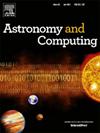SSOXmatch:一个Java管道,用于计算天文观测中太阳系天体的交叉匹配
IF 1.8
4区 物理与天体物理
Q2 ASTRONOMY & ASTROPHYSICS
引用次数: 0
摘要
在本文中,我将描述一个使用Java编程语言开发的新软件包,旨在计算任何太阳系天体(在小行星、彗星、行星和卫星中)的位置,以帮助在地球和太空观测站的观测中执行它们的交叉匹配。支持的太空望远镜有哈勃、詹姆斯·韦伯、欧几里得、xmm -牛顿、斯皮策、赫歇尔、盖亚、开普勒、钱德拉和苔丝,尽管软件的灵活性允许支持任何其他任务,而不需要改变一行代码。轨道元素可以从洛厄尔天文台的小行星数据库(由LTE维护的彗星数据库cometpro完成)和喷气推进实验室的小天体数据库中选择。该软件不依赖于外部工具,并执行自己的小体数值积分。为太阳系实现的动力学模型包括所有主要天体的引力效应,包括地球、月球和冥王星作为单独的天体,16个干扰小行星(如在其他工具中),广义相对论效应,太阳、地球和月球的扁率,以及彗星和小行星的非引力。一套完整的web服务允许计算交叉匹配(稍后进行确认,例如通过视觉检查图像)和特定物体的星历。代码是高度优化的,并遵循软件质量和文档方面的最高标准。本文章由计算机程序翻译,如有差异,请以英文原文为准。

SSOXmatch: A Java pipeline to compute cross-matches of Solar System bodies in astronomical observations
In this paper I will describe a new software package developed using the Java programming language, aimed to compute the positions of any Solar System body (among asteroids, comets, planets, and satellites) to help to perform cross-matches of them in observations taken from earth- and space-based observatories. The space telescopes supported are Hubble, James Webb, Euclid, XMM-Newton, Spitzer, Herschel, Gaia, Kepler, Chandra, and TESS, although the flexibility of the software allows to support any other mission without the need to change a single line of code. The orbital elements can be selected among the asteroid database from the Lowell observatory (completed with the cometpro database of comets maintained by the LTE), and the JPL database of minor bodies.
The software does not depend on external tools, and performs its own numerical integration of minor bodies. The dynamical model implemented for the Solar System includes the gravity effects of all major bodies, including the Earth, Moon, and Pluto as individual bodies, 16 perturbing asteroids as in other tools, the General Relativity effects, the oblateness of the Sun, Earth, and Moon, and the non-gravitational forces for both comets and asteroids. A complete set of web services allow to compute the cross-matches (that are later to be confirmed, for instance by visual inspection of the images) and also ephemerides of specific bodies. The code is highly optimized and follows the highest standards in terms of software quality and documentation.
求助全文
通过发布文献求助,成功后即可免费获取论文全文。
去求助
来源期刊

Astronomy and Computing
ASTRONOMY & ASTROPHYSICSCOMPUTER SCIENCE,-COMPUTER SCIENCE, INTERDISCIPLINARY APPLICATIONS
CiteScore
4.10
自引率
8.00%
发文量
67
期刊介绍:
Astronomy and Computing is a peer-reviewed journal that focuses on the broad area between astronomy, computer science and information technology. The journal aims to publish the work of scientists and (software) engineers in all aspects of astronomical computing, including the collection, analysis, reduction, visualisation, preservation and dissemination of data, and the development of astronomical software and simulations. The journal covers applications for academic computer science techniques to astronomy, as well as novel applications of information technologies within astronomy.
 求助内容:
求助内容: 应助结果提醒方式:
应助结果提醒方式:


